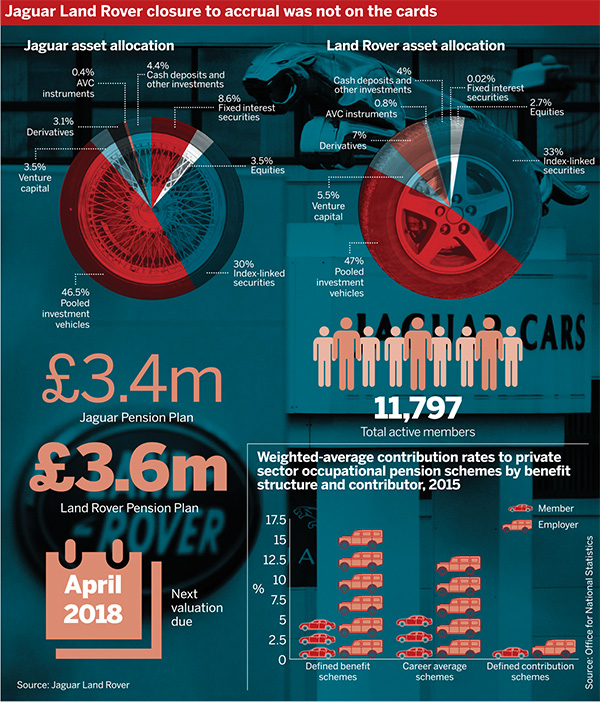Jaguar Land Rover is switching its defined benefit schemes from final salary to a career average revalued earnings structure, as companies look to cut costs and manage risk while keeping employees on board.
A number of employers have already moved to Care over the past year, including Leonardo and Diageo.
Earlier this year, members of the £3.6bn Land Rover Scheme and the £3.4bn Jaguar Pension Plan were informed that the company had announced a period of formal pension consultation.
If the goal is to come up with a cheaper benefit than the final salary, then thought needs to go into making sure that that does actually deliver the goal
Claire van Rees, Sackers
A Jaguar Land Rover spokesperson said that this consultation closed in March and the company “has amended the structure of its UK defined benefit schemes changing these from a final salary basis to a career average revalued earnings basis for service from 6 April 2017”.
Package of pension changes
Pensions built up prior to this date will increase each year up until their retirement “to help keep up with the cost of living”, but this increase will no longer be linked to future salary growth.
“Most DB members have the option to choose between a higher or lower rate to build up their benefits depending on how much they choose to contribute,” the spokesperson explained.

The spokesperson added: “The rate at which members of JLR’s UK DB schemes may exchange pension for cash at retirement has been improved substantially for most members”.
The proposals did not involve closing the scheme to future accrual.
“We understand how much employees value this type of benefit so we have worked hard to establish a package of changes that are intended to improve the sustainability of the pension schemes whilst maintaining defined benefit provision for current active members,” said the spokesperson.
Companies need a convincing argument
Companies that are struggling financially have historically been able to make quite a good argument for moving away from final salary, said Claire van Rees, partner at law firm Sackers.
However, more recently some stronger employers have wanted to limit pension liabilities in this way, but given that they are not struggling, they find themselves “not really being able to make that argument convincingly”, she noted.
So while a well positioned company might well want to limit its DB exposure and the volatility of funding, “they’ve had a lot of push-back from the unions and employees”, van Rees said.
There is an assumption Care is going to be less expensive, but it all depends on how the benefits are designed with regard to revaluation, she explained.
“If the goal is to come up with a cheaper benefit than the final salary, then thought needs to go into making sure that that does actually deliver the goal,” she said.
She also said strong employers sometimes propose a move to DC entirely, “but the push-back has meant that they’ve landed on keeping a DB element with Care”.
Care offers middle ground
Adam Poulson, associate and head of corporate consulting for the north at Barnett Waddingham, said: “Moving to a Care benefit provides a bit of a middle ground. From a company point of view it reduces cost and risk… and from an employee point of view it’s going to provide a valuable defined benefit pension,” given that it is not as drastic as a move to DC.
Diageo’s Care scheme proposal highlights struggle over DB provision
Last year, two unions balloted members over industrial action in a pensions dispute with Diageo, as the UK-based multinational proposed replacing its final salary scheme with a career average arrangement.
Poulson noted that the scheme’s decision to give members access to higher contributions, if they commit to saving more themselves, “is quite an interesting switch” and allows the employer to direct its contributions towards members that value it the most, while encouraging to save more.
Martin Hunter, principal at Punter Southall Transaction Services, said that “you can make Care very generous if you were to revalue it by, say, 5 per cent each year”, so “the structure itself doesn’t automatically mean it’s going to be less generous, it’s just that in practical terms it usually is” .
He said some employers have retained final salary but placed a cap on pensionable pay increase to manage costs. This can also be simpler than setting up a new Care structure, which is “quite a substantial overhaul of the whole kind of framework of a pension scheme” and makes it more complicated to calculate pensions.














